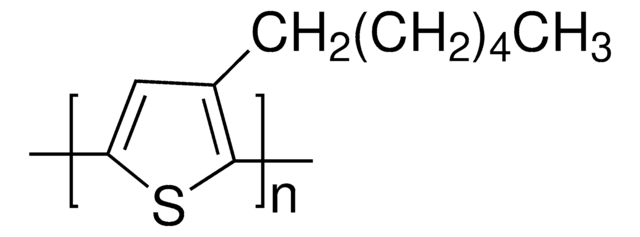900181
PEDOT:PSS
high-conductivity grade, 0.5-1 wt. % aqueous dispersion
Synonym(s):
1% Pedot/PSS, Orgacon™ S315, Poly(2,3-dihydrothieno-1,4-dioxin)-poly(styrenesulfonate)
About This Item
Recommended Products
Product Name
Poly(3,4-ethylenedioxythiophene)-poly(styrenesulfonate), high-conductivity grade
grade
high-conductivity grade
Quality Level
description
Visual Light Transmission (VLT): ≥ 80%
form
dispersion
greener alternative product characteristics
Design for Energy Efficiency
Learn more about the Principles of Green Chemistry.
sustainability
Greener Alternative Product
concentration
0.5-1 wt. % (PEDOT: PSS in water)
sheet resistance
<200 Ω/sq (coating : 40μ wet, drying: 6 min 130°C)
pH
2-3.5
viscosity
≤70 mPa.s(20 °C)
greener alternative category
, Enabling
storage temp.
2-8°C
SMILES string
CC1=C2OCCOC2=C(C)S1.CCC(C3=CC=CC=C3)C.C[SO3-]
General description
- low band gap
- good optical properties
- high conductivity
- low redox potential
- easy processing
- tunable film forming ability
Application
- ITO substitution coating.
- ITO-free OPV.
- Surface electrical resistance (SER) at 90% VLT* (visual light transmission): 125 Ω/square.
- Stability ratio R/R_0 (500 hr at 60 °C, 95% RH) : 1.3.
Preparation Note
- Dilute with DI water or compatible solvent if needed.
- Pre-treated substrate with corona- or plasma treatment increase adhesion.
Other Notes
- These additives have low water content (less than 100 ppm).
- Please handle under inert and moisture free environment (glove box).
- Keep containers tightly closed.
- Keep away from heat and ignition sources.
- Store in a cool and dry place.
- Avoid storing together with oxidizers.
Legal Information
Signal Word
Warning
Hazard Statements
Precautionary Statements
Hazard Classifications
Eye Irrit. 2 - Skin Irrit. 2
Storage Class Code
12 - Non Combustible Liquids
WGK
WGK 2
Flash Point(F)
Not applicable
Flash Point(C)
Not applicable
Choose from one of the most recent versions:
Already Own This Product?
Find documentation for the products that you have recently purchased in the Document Library.
Articles
A detailed article on conducting polymer materials for flexible organic photovoltaics (OPVs) applications.
Advancements in bioelectronics, incorporating self-healing materials for wearable devices, and measuring bioelectric signals to assess physiological parameters.
Progress in Organic Thermoelectric Materials & Devices including high ZT values of >0.2 at room temperature by p-type (PEDOT:PSS) & n-type (Poly[Kx(Ni-ett)]) materials are discussed.
To achieve net-zero emissions by 2050, renewable power contributions must triple. Photovoltaic stations provide vital utility power, achieved primarily through third- and fourth-generation technology. Promising trends include recycling and revolutionary, ultra-lightweight, flexible, and printable solar cells.
Active Filters
Our team of scientists has experience in all areas of research including Life Science, Material Science, Chemical Synthesis, Chromatography, Analytical and many others.
Contact Technical Service




![[6,6]-Phenyl C61 butyric acid methyl ester ≥99%](/deepweb/assets/sigmaaldrich/product/structures/359/221/d990c746-0960-4c69-bf76-fe09b193824d/640/d990c746-0960-4c69-bf76-fe09b193824d.png)



